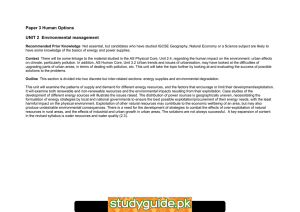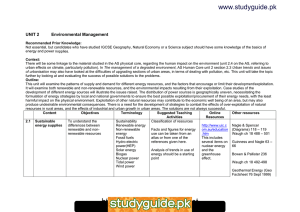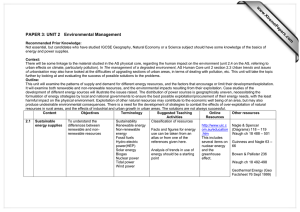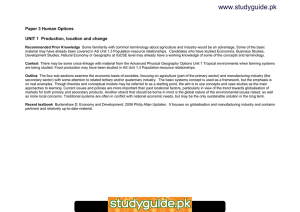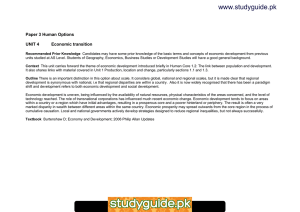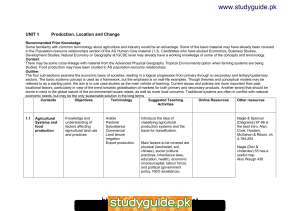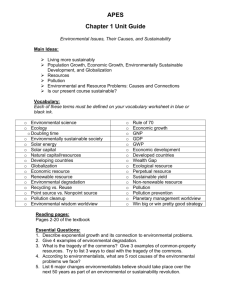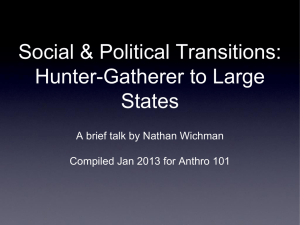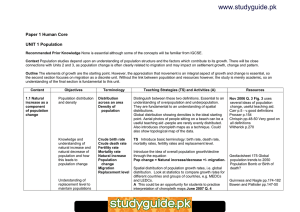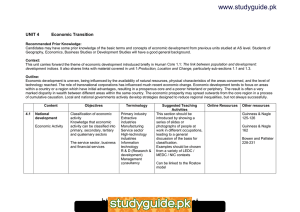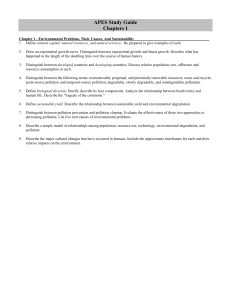www.studyguide.pk Paper 3 Human Options UNIT 2 Environmental management
advertisement
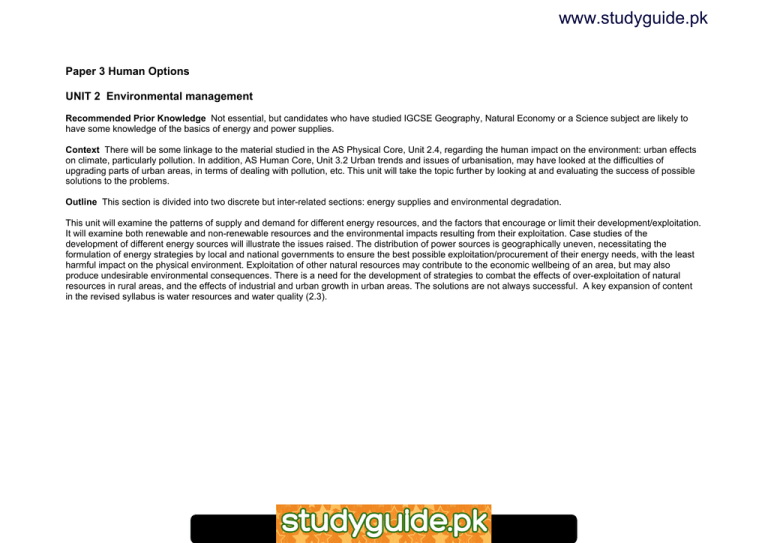
www.studyguide.pk Paper 3 Human Options UNIT 2 Environmental management Recommended Prior Knowledge Not essential, but candidates who have studied IGCSE Geography, Natural Economy or a Science subject are likely to have some knowledge of the basics of energy and power supplies. Context There will be some linkage to the material studied in the AS Physical Core, Unit 2.4, regarding the human impact on the environment: urban effects on climate, particularly pollution. In addition, AS Human Core, Unit 3.2 Urban trends and issues of urbanisation, may have looked at the difficulties of upgrading parts of urban areas, in terms of dealing with pollution, etc. This unit will take the topic further by looking at and evaluating the success of possible solutions to the problems. Outline This section is divided into two discrete but inter-related sections: energy supplies and environmental degradation. This unit will examine the patterns of supply and demand for different energy resources, and the factors that encourage or limit their development/exploitation. It will examine both renewable and non-renewable resources and the environmental impacts resulting from their exploitation. Case studies of the development of different energy sources will illustrate the issues raised. The distribution of power sources is geographically uneven, necessitating the formulation of energy strategies by local and national governments to ensure the best possible exploitation/procurement of their energy needs, with the least harmful impact on the physical environment. Exploitation of other natural resources may contribute to the economic wellbeing of an area, but may also produce undesirable environmental consequences. There is a need for the development of strategies to combat the effects of over-exploitation of natural resources in rural areas, and the effects of industrial and urban growth in urban areas. The solutions are not always successful. A key expansion of content in the revised syllabus is water resources and water quality (2.3). www.xtremepapers.net www.studyguide.pk Content 2.1 Sustainable energy supplies Objectives To understand the differences between renewable and nonrenewable energy resources Terminology Sustainability Renewable energy Non-renewable energy Energy budget Fossil fuels Hydro-electric power (HEP) Solar energy Biofuels Tidal power Wind power Nuclear power Technology Suggested Teaching Activities Classification of resources: renewable and non-renewable. Facts and statistics for energy use can be taken from an atlas or from one of the references given here. Analysis of trends in use of energy should be a starting point e.g. energy demand and supply in a country in 2005 and 2020. It is important that there is detail about each of the sources of energy in this section. Questions may focus on a particular source of energy - requirements for production, location, contribution to energy budget, etc. Suggested case studies: USA - energy alternatives for the future Wind farms in Europe - a topical issue www.xtremepapers.net Online Resources http://www.uic.c om.au/educatio n.htm This includes items on nuclear energy and the greenhouse effect. Other resources Nagle & Spencer (Diagrams) pp.118-119 Waugh chapter 18 pp.488501 Guinness and Nagle pp.63-66 Bowen & Pallister p.236 Waugh chapter 18 pp.492498 June 2004 Q. 11(a) June 2005 Q. 11 June 2006 Q. 3(a) June 2007 Q. 3(a) November 2008 Q. 3 All these questions demand detailed knowledge. Geothermal Energy (Geo Factsheet 76 Sept 1999) www.studyguide.pk To understand why levels of supply and demand for energy resources vary at the national level This section is focussed on demand and supply and the relationships between them To examine trends in the patterns of energy consumption in LEDCs and MEDCs Demand Supply Resource endowment Technology Energy gap Factors that influence energy policy e.g. level of development, capital, energy policy, environmental concerns, Kyoto targets, etc. Maps and statistics can be studied to show that the main producers of energy are not necessarily the main consumers. Local case studies are encouraged and often highly effective. A good starting point is Waugh 489-491 (graphs and data). Relate to changes in technology. Trends in consumption. Comparison of statistics for present demand/ supply and future demand/supply. e.g. for 2005 and 2020. Possible comparison of LEDCs and MEDCs. This could be picked up as part of the case study (2.2). www.xtremepapers.net June 2004 Q. 11(b) energy consumption in LEDCs Bowen & Pallister pp.238241 Nagle (Development & Underdevelopment) pp.111- 114 Nagle & Spencer (Diagrams) p.115 (dated, but can be used for comparison purposes). Guinness & Nagle pp.5662 Waugh pp.489-91 www.studyguide.pk To understand the environmental impact of energy production, transport and usage at the local scale Note Impact on people (human impact) is not needed. To understand the environmental impact of energy production, transport and usage at the global scale Environmental impact Natural environment Pollution Degradation Conservation All energy production has some environmental impact (including renewables). Fuel extraction and electricity production create industrial waste, transport may spill crude oil, etc. This can be demonstrated by use of case studies e.g. Exxon Valdez oil spill or the Trans-Alaska pipeline which has great effects on the natural environment. Nuclear energy has distinct actual and potential impacts locally which may impact wider areas e.g. Chernobyl. Data of carbon dioxide emissions and levels of deforestation can be analysed, considering ‘Carbon sinks’, and a link made to Tropical environments, Physical Options Unit 1. Could compare burning fossil fuels with nuclear energy, which may be seen as “clean” but has other possible dangers. www.xtremepapers.net http://www.iclei. org/EFACTS/GL BWFIG1.GIF (diagram) http://www.iclei. org/EFACTS/GL OBWARM.HTM (global warming) Other links on this site explore alternative energy sources and their effects. June 2006 Q. 3(a)(i) Fig. 2 http://www.uic.c om.au/educatio n.htm deals with Australian uranium Nagle (Development & Underdevelopment) p.111 Cook, Hordern et al. pp. 119-20 is very good. Cook, Hordern et al. p.125, p.129 Waugh p.495 www.studyguide.pk 2.2 The management of energy supply To examine and evaluate the supply of electrical energy in one country at two scales Demand Supply Energy gap Production Location 1. Overall energy strategy (national) 2. Named, located energy scheme (local) 2.3 Environmental degradation To understand the nature and causes of the many types of pollution To distinguish pollution from environmental degradation To analyse the factors which have led to degradation of rural environments. Causes and consequences of misuse or overuse of rural land Environmental degradation Land pollution Air pollution Water pollution May also include: Noise pollution Visual Pollution Population pressure Soil erosion Land degradation Deforestation Desertification Poor farming practices One case study is sufficient as long as it covers both scales, e.g. of Zimbabwe and Kariba (HEP). Teachers may develop more than one case study, e.g. the home country and a contrast (LEDC or MEDC). It is anticipated that the scheme studied will be from the same country as the strategy, to offer greater detail and depth. Industries in all four sectors can pollute land, air and water. Definition. Classification. Causes and sources of pollution as an introduction. Can use spider diagram to brainstorm the topic. Add water as a resource to the discussion. Could link to AS Unit 1 Hydrology through water quality, abstraction, etc. Could Physical Options, Unit 4 Arid and semi-arid environments. Past questions can indicate emphasis that should be made when interpreting the syllabus. Degradation of rural environments occurs in both MEDCs and LEDCs. Suggested case study from home country or any context which students can readily understand. www.xtremepapers.net June 2007 Q. 3(b) Nov 2006 Q. 3(b) Nagle (Development & Underdevelopment) pp.111-114 Geo Factsheet 95 April 2000 UK Energy – Update Nov 2005 Q. 11(b) Nov 2008 Q. 4(b) water pollution June 2008 Q. 4 June 2007 Q. 4 Fig. 2 shows water supply - a useful teaching resource. Nov 2006 Q. 4 pollution June 2004 Q. 12(b) involves evaluation of factors such as finance in the upgrading of the environment. Cook, Hordern et al. pp.114-123 Nagle (Development & Underdevelopment) pp.6667 Hart et al. pp.133-136 www.studyguide.pk To examine and evaluate policies designed to improve the quality of degraded rural environments To understand why selected urban environments have become degraded Note Teachers may want to compare one MEDC and one LEDC city but this is not necessary. To understand the relative success or failure of policies designed to address urban environmental degradation Reclamation Land reform Soil conservation Afforestation Environmentally Sensitive Areas (ESAs) Waste disposal Urbanisation Urban decay Zones of discard and assimilation Inner city Informal settlement Waste management - solid, liquid, gas and particulates Urban regeneration Urban redevelopment Case study – Basilicata, Italy, is a very good, up-to-date case study to use. Case study 1: The problems of the city of Rome, Italy Hill (Advanced Geography Case Studies) pp.54-60 Nov 2005 Q. 12 (a) urban degradation Hill pp.89-95 Case study 2: Cairo, Egypt: Africa’s largest city Hill pp.96-105 Case study 3: American cities Case study 4: The quality of life in cities Guinness & Nagle pp.7074 Guinness & Nagle pp.8994 on American cities Guinness & Nagle pp.95105 Nagle & Spencer (Diagrams) p.94, an older project but still useful Cook, Hordern et a. pp.9294 Guinness & Nagle pp.109113, pp.114-119 Waugh pp.402-3, p. 408 Case study 5: urban redevelopment in Glasgow, UK Case study 6: inner city areas Case study 7: São Paulo, Brazil Case study 8: London Docklands There may be links to AS Unit 3.4 The management of urban settlements Case studies are a matter of individual choice. www.xtremepapers.net http://www.foei. 0rg/media/index .html Geo Factsheet 121 January 2002 Urban Problems in Rio de Janeiro www.studyguide.pk Knowledge of risk factors affecting environments, environmental protection policies and their impact 2.4 The management of a degraded environment To acquire detailed knowledge of one degraded environment Factors, causes, problems, issues, management strategy, attempts or initiatives, and relative success or failure are the key elements Examples are diverse and may include: National Parks Nature reserves Mining agreements Tropical rainforest (TRF) Ecotourism Earth summits Kyoto protocol CO2 emissions targets Factors that cause and influence degradation: economic, social, environmental, political. Positive and negative. Identifying risk factors: general risk factors e.g. population pressure and specific risk factors (to time and/or place) e.g. road building project. Awareness of the need for some form of environmental protection. Measures: proposed or taken. Outcomes: relative success/failure. Unexpected effects, further needs, etc. Study of the Earth summits of Rio de Janeiro 1996 and Kyoto 1997 and the targets of the Kyoto Protocol. Possible link back to AS Unit 2 Atmosphere and weather, 2.4 The human impact This section may be covered by reference to any case study of a teacher’s or student’s choice. Note Be careful to ensure that the chosen case study has all the attributes needed. It is advisable to check the wording of past questions in order to select a case study that fulfils the question requirements. www.xtremepapers.net Nov 2006 Q. 4(b) government as a factor June 2005 Q. 12(b) Geo Factsheet 91 April 2000 Cardiff Bay Redevelopment, UK
